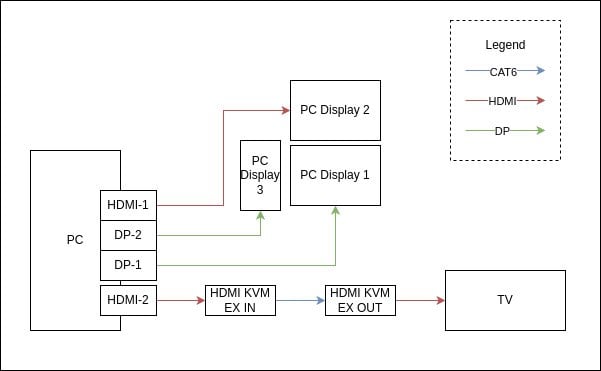If the KVM tells the PC that the TV has been disconnected, then you can just disable the other screens in the display settings while the TV is connected, and it'll just work. Which screens are enabled or disabled is remembered depending on the currently connected displays.
Didnt know this, nice, thanks :)
I do this with a projector.
When the projector is off, it is not detected by my GPU. When it is on, it is.
I simply configured the display config while the projector was on, with disabled monitors.
When the projector is turned off, it disappears, which triggers the normal, no-projector config.
My monitors now go blank, and come back, depending on whether the projector is on.
If removing the physical connector achieves the exact result you're looking for, might it just be easier to get, or build, some manual on-off/disconnect toggles?
If you can't find purpose-built options, and you aren't comfortable building your own, maybe a manual toggle box for HDMI that you can switch to an empty port, as needed.
Alternatively, what about a script, or macro, to switch to mirror mode, and back again?
OMG, this solution was so simple, but completely just worked. Just mirrored the main display and fixed individual refresh rates, even works when turning the extender on and off. Thanks a bunch for the inspiration! Had my head breaking over this!
Haha nice, I'm glad I threw that in at the bottom lol.
If you do end up needing to do something physical, and can't find a prefabricated item, look at getting 2 female HDMI breakout boards/connectors.
I believe there's 19 wires in total, but only two deal with power (+/-) and 1 that deals with clock signal (tmds?). Could probably move those over to 3 pin on/off toggle switch, directly wire the rest, and then flip the switch as needed.
Or even just the TMDS wire 1 pin toggle switch, might even do the trick.
Those pinouts might be different based on the HDMI version you're using, and I cannot stress this enough, I pulled that idea mostly out of my ass. I have some experience with this type of DIY, but none of it was with HDMI signals.
It is not intended as a final blueprint, just a starting point you figuring out a DIY toggle.
Hmm, hadn't thought of just setting all the displays to mirror mode, might want to test what that does (especially since the displays are of varying resolutions and refresh rates). I suppose it could work.
I have thought of a physical switch but i haven't had any luck finding a prebuilt one and I don't much have the electronics know-how to build one.
KDE
KDE is an international technology team creating user-friendly free and open source software for desktop and portable computing. KDE’s software runs on GNU/Linux, BSD and other operating systems, including Windows.
Plasma 6 Bugs
If you encounter a bug, proceed to https://bugs.kde.org, check whether it has been reported.
If it hasn't, report it yourself.
PLEASE THINK CAREFULLY BEFORE POSTING HERE.
Developers do not look for reports on social media, so they will not see it and all it does is clutter up the feed.
